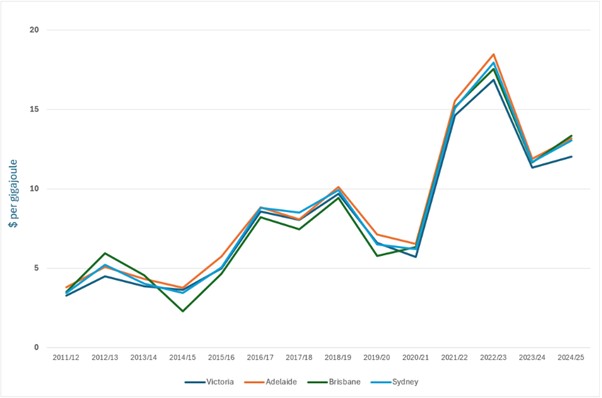Winter Bills: Is it cheaper to heat your house with gas or electricity?
Gas prices in Australia have seen significant fluctuations in recent years, driven by a combination of global market dynamics, domestic supply constraints, and rising demand. As both a major exporter of liquefied natural gas (LNG) and a domestic consumer across residential, commercial, and industrial sectors, Australia’s prices are increasingly influenced by international trends. The east coast market, in particular, has faced upward pressure due to limited infrastructure and competition from export contracts. As of financial year 2024/25, average wholesale gas prices have come down from the 2022/23 peak, but they remain at the third-highest level over the past fifteen years (Figure 1).
Although wholesale prices do not directly affect household power bills, sustained high prices flow through to retail prices in the coming years. For households and businesses, this volatility affects energy costs and decision-making, as consumers increasingly consider alternatives such as electrification and investments in Consumer Energy Resources (CER) in response to rising prices.
Figure 1: Average gas prices $/GJ for the Victorian gas market, STTM hubs in Adelaide, Brisbane and Sydney

Source: Australian Energy Council’s analysis
In Victoria, these price pressures are particularly acute during winter, when gas heating demand peaks. Melbourne households typically see their highest gas bills between June and August, as shorter daylight hours increase electricity use while gas heating surges. The state has the highest rate of residential gas consumption in the country (see Table 1). This heavy reliance on gas heating during the colder months makes Melbourne the most relevant location for examining the economic viability of switching to solar-powered electric alternatives. We will compare household bills using traditional gas heating with those using electric heating systems supported by rooftop solar generation.
Table 1: Natural Gas Consumption (TJ) by residential and small businesses during financial year 2023-24
![]()
Source: 2025 Electricity Gas Australia, Australian Energy Council
Table 2: Average gas usage in winter and summer by household sizes

Source: Frontier Economics - Simple electricity and gas benchmarks - From June 2021
The sharp seasonal difference is primarily due to space heating, as gas use for hot water and cooking remains relatively steady year-round. This highlights that the vast majority of gas consumption in Victorian homes during winter is driven by heating demand, not other appliances. Research by Frontier Economics indicates that for the average family of four, the additional 21,732 MJ consumed during winter can result in a gas bill of roughly $1000. Larger households of five or more typically use 27,348 MJ more during winter, with gas bills exceeding $1,300.
Table 3: Estimated Winter (June, July & August) Gas Bill in Victoria by household sizes

Source: Frontier Economics - Simple electricity and gas benchmarks - From June 2021, Australian Energy Council’s analysis
*Average rate of all gas retailers across different gas distributor regions
*Many gas retailers use tiered pricing (e.g. different rates for the first 27 MJ). For simplicity, a flat rate (c/MJ) is assumed in this analysis.
While the gas market is competitive, many consumers focus on switching electricity plans rather than gas, often leaving money on the table with their gas bills. One way to reduce the impact of high winter gas bills is to consider electric heating alternatives, particularly those powered by energy-efficient appliances or rooftop solar systems.
To fairly compare gas and electric heating costs, we first estimate the electricity required to deliver the same amount of heat currently provided by gas during winter. This depends on the efficiency of electric heating systems, with reverse-cycle air conditioners among the most efficient. A reverse-cycle system has a coefficient of performance (COP) of 3–5, delivering 3 to 5 units of heat for every unit of electricity consumed. Using this efficiency factor, household gas consumption (in MJ) can be converted into the equivalent electricity demand (in kWh) needed to provide the same level of heating.
To establish an accurate baseline for electricity use without heating or cooling loads, this analysis uses autumn consumption data. Autumn in Melbourne requires minimal space heating or air conditioning, reflecting true household electricity use for lighting, appliances, and hot water. Unlike spring, autumn’s lower solar generation avoids artificially reduced consumption from the 35–40 per cent of Victorian households with existing solar systems. The converted gas heating demand is then added to this autumn baseline to estimate total winter electricity requirements for households switching to electric heating.
Table 4: Estimated total winter electricity usage in Victoria

Source: Frontier Economics - Simple electricity and gas benchmarks - From June 2021, Australian Energy Council’s analysis
Note: Total = autumn electricity usage + converted gas usage for heating into electricity (from MJ into kWh)
As shown in Table 5, even without solar, electricity bills are already competitive with gas for many household sizes, particularly in lower-cost distribution regions such as Jemena or United Energy.
Table 5: Estimated Winter (June, July & August) Electricity Bill in Victoria by household sizes

Source: ESC, Australian Energy Council’s analysis
While reverse-cycle electric heating is already comparable in cost to gas for many households, adding a solar PV system can reduce quarterly electricity bills even further across all household sizes. Table 6 shows the potential savings for Victorian families. Single-person households typically need around 3 kW of solar panels to reduce their winter bills to $473–$587, while larger households generally require 6.6–8 kW systems for the greatest savings.
Table 6: Estimated Winter (June, July & August) Electricity Bill with rooftop solar systems in Victoria by household sizes

Source: ESC, Australian Energy Council’s analysis
While ongoing energy costs are clearly reduced, households should be mindful of the initial capital investment required to install rooftop solar or upgrade to reverse-cycle heating systems, which can vary depending on system size, existing infrastructure, and available rebates. The latest federal battery rebate scheme further strengthens the economic case, allowing households to store excess solar and reduce their winter electricity bills even more.
This article is an extract from the Australian Energy Council’s Solar Report Q2 2025. For the full analysis and detailed data, see the complete report here.
Related Analysis
Getting it right: How to make the “Solar Sharer” work for everyone
On paper, the government’s proposed "Solar Sharer Offer" (SSO) sounds like the kind of policy win that everyone should cheer for. The pitch is delightful: Australia has too much solar power in the middle of the day; the grid is literally overflowing with sunshine: let’s give households free energy during 11am and 2pm. But as the economist Milton Friedman famously warned, "There is no such thing as a free lunch." Here is a no-nonsense guide to making the SSO work.
The energy transition and power bills: Why aren’t they cheaper?
With energy prices increasing for households and businesses there is the question: why aren’t we seeing lower bills given the promise of cheaper energy with increasing amounts of renewables in the grid. A recent working paper published by Griffith University’s Centre for Applied Energy Economics & Policy Research has tested the proposition of whether a renewables grid is cheaper than a counterfactual grid that has only coal and gas as new entrants. It provides good insights into the dynamics that have been at play.
The gas transition: What do gorillas have to do with it?
The gas transition poses an unavoidable challenge: what to do with the potential for billions of dollars of stranded assets. Current approaches, such as accelerated depreciation, are fixes that Professorial Fellow at Monash University and energy expert Ron Ben-David argues will risk triggering both political and financial crises. He has put forward a novel, market-based solution that he claims can transform the regulated asset base (RAB) into a manageable financial obligation. We take a look and examine the issue.
Send an email with your question or comment, and include your name and a short message and we'll get back to you shortly.



